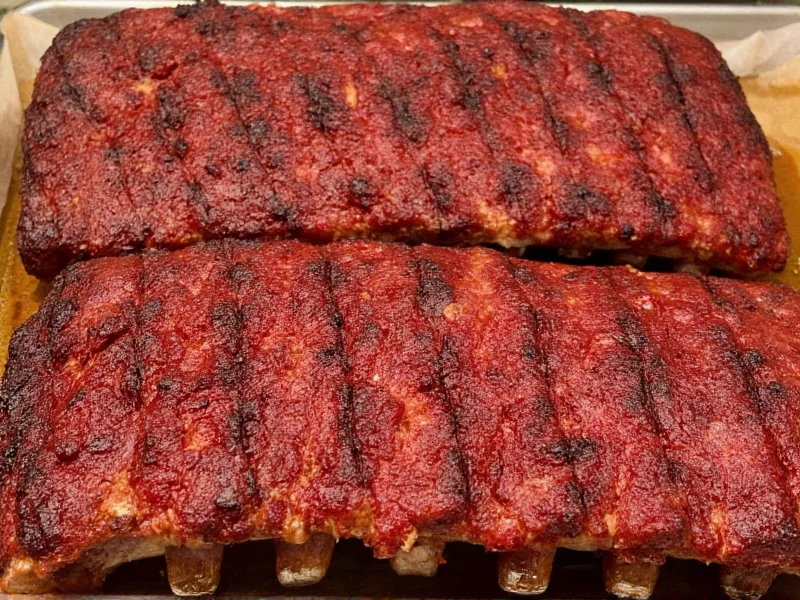Understanding the proper temperature for ribs goes beyond basic food safety. Many home cooks make the mistake of pulling ribs too early, resulting in tough, chewy meat that hasn't properly rendered. The difference between merely safe and truly delicious ribs comes down to temperature science and patience.
The Science Behind Rib Temperature
Ribs contain significant amounts of collagen, the connective tissue that makes meat tough when raw. As ribs cook, this collagen gradually converts to gelatin, which creates that melt-in-your-mouth texture. This transformation begins around 160°F (71°C) but doesn't complete until temperatures reach 190°F (88°C) or higher.
Unlike steaks or chicken breasts where precise temperature equals doneness, ribs require what's known as extended temperature exposure. The meat continues to tenderize even after reaching the target temperature, which is why many pitmasters recommend wrapping ribs during the "stall" phase when evaporation cools the meat surface.
Rib Temperature Guide by Type
| Rib Type | Minimum Safe Temp | Optimal Tender Temp | Texture Indicator |
|---|---|---|---|
| Pork Baby Back Ribs | 145°F (63°C) | 190-203°F (88-95°C) | Meat retracts 1/2" from bones |
| Pork Spare Ribs | 145°F (63°C) | 195-205°F (90-96°C) | Bend test with slight droop |
| Beef Short Ribs | 145°F (63°C) | 200-208°F (93-98°C) | Fork slides in with no resistance |
| St. Louis Cut Ribs | 145°F (63°C) | 192-200°F (89-93°C) | Bone easily twists out |
Measuring Temperature Correctly
Accurate temperature readings require proper technique. Insert your thermometer probe into the thickest part of the meat, avoiding bones which can give false high readings. For best results:
- Use an instant-read thermometer for spot checks
- Place a leave-in probe thermometer between bones
- Take multiple readings across the rack
- Check temperature in the "plate" area (meatiest section)
Many beginners make the error of checking temperature too frequently, which releases precious juices. Limit thermometer checks to every 30 minutes during the final cooking phase. Remember that ribs continue to cook during resting—typically rising 5-10°F (3-6°C)—so remove them from heat just before reaching your target temperature.
Visual and Physical Doneness Tests
While temperature provides the most reliable measurement, experienced cooks use complementary methods to verify rib doneness:
The Bend Test
Using tongs, lift the rack from one end. Properly cooked ribs will bend significantly, developing a crack on the surface when bent to 45 degrees. Overcooked ribs will bend too easily and may break apart.
Meat Retraction
As ribs cook, the meat shrinks back from the bones. When done, you should see approximately 1/2 inch of exposed bone at each end. This visual cue works best with baby back ribs.
Finger Pressure Test
Gently press between bones with your finger. Done ribs will feel soft and yield easily, similar to pressing your cheek. Undercooked ribs will feel firm like your forehead, while overcooked ribs feel mushy like your chin.
Temperature Adjustments for Cooking Methods
Different cooking techniques require slight temperature variations:
- Smoking (225-250°F): Target 200-205°F for maximum tenderness
- Oven Roasting (275°F): Pull at 195°F as higher heat accelerates cooking
- Grilling (indirect): Monitor closely as flare-ups cause uneven cooking
- Sous Vide: Cook at 165°F for 24-36 hours, then finish with high heat
When wrapping ribs in foil or butcher paper (the "Texas crutch"), expect a faster temperature rise during the final stages. This technique helps push through the stall but requires closer monitoring to prevent overcooking.
Troubleshooting Temperature Issues
Ribs done too early: If your ribs reach target temperature before developing bark or smoke flavor, reduce cooking temperature and extend cooking time. You can also unwrap and return to heat for additional smoke exposure.
Tough ribs at proper temperature: This usually indicates insufficient cooking time at temperature rather than incorrect final reading. Return to heat and check every 15 minutes until tender. The collagen needs time to fully convert even after reaching temperature.
Temperature plateau (the stall): Between 150-170°F, evaporation cools the meat surface, causing temperature to stabilize for hours. This is normal—be patient or wrap to push through the stall.
Resting for Perfect Results
Never skip the resting phase. After removing ribs from heat, wrap them tightly in foil and then in a towel, placing in a cooler or warm oven (170°F) for 30-60 minutes. This allows:
- Temperature equalization throughout the meat
- Further collagen breakdown without additional cooking
- Juice redistribution for maximum succulence
- Carryover cooking to reach final target temperature
Properly rested ribs will maintain their ideal temperature range while becoming even more tender. Cutting too soon releases precious juices onto your cutting board rather than staying in the meat.











 浙公网安备
33010002000092号
浙公网安备
33010002000092号 浙B2-20120091-4
浙B2-20120091-4